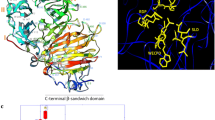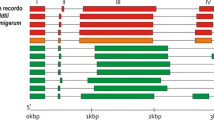Abstract
To determine the relationship between invertase gene expression and glucose and fructose accumulation in ripening tomato fruit, fruit vacuolar invertase cDNA and genomic clones from the cultivated species, Lycopersicon esculentum cv. UC82B, and a wild species, Lycopersicon pimpinellifolium, were isolated and characterized. The coding sequences of all cDNA clones examined are identical. By comparison to the known amino acid sequence of mature L. esculentum fruit vacuolar invertase, a putative signal sequence and putative amino-terminal and carboxy-terminal propeptides were identified in the derived amino acid sequence. Of the residues 42% are identical with those of carrot cell wall invertase. A putative catalytic site and a five-residue motif found in carrot, yeast, and bacterial invertases are also present in the tomato sequence. Minor differences between the nucleotide sequences of the genomic clones from the two tomato species were found in one intron and in the putative regulatory region. The gene appears to be present in one copy per haploid genome. Northern analysis suggests a different temporal pattern of vacuolar invertase mRNA levels during fruit development in the two species, with the invertase mRNA appearing at an earlier stage of fruit development in the wild species. Nucleotide differences found in the putative regulatory regions may be involved in species differences in temporal regulation of this gene, which in turn may contribute to observed differences in hexose accumulation in ripening fruit.
Similar content being viewed by others
References
Ahmad I, Finkelstein JA, Steggles AW: The analysis of RNA by in situ hybridization is more sensitive than the equivalent northern blot analysis. Bio Techniques 8: 162–165 (1990).
Bianchi A, Foriani A, Manunta C: Sugar content in tomatoes. Tomato Genet Coop 3: 6 (1953).
Bustos MM, Guiltinan MJ, Jordano J, Begum D, Kalkan FA, Hall TC: Regulation of β-glucuronidase expression in transgenic tobacco plants by an A/T-rich, cis-acting sequence found upstream of a French bean β-phaseolin gene. Plant Cell 1: 839–853 (1989).
Callis J, Fromm M, Walbot V: Introns increase gene expression in cultured maize cells. Genes Devel 1: 1183–1200 (1987).
Davies JN: Occurrence of sucrose in the fruit of some species of Lycopersicon. Nature 209: 640–641 (1966).
deVries S, Hoge H, Bisseling T: Isolation of total and polysomal RNA from plant tissues. In: Gelvin SB, Schilperoort RA, Verma DPS (eds) Plant Molecular Biology Manual, pp. B6/1-B6/13. Kluwer Academic Publishers, Dordrecht (1988).
Devereux J, Haeberli P, Smithies O: A comprehensive set of sequence analysis programs for the VAX. Nucl Acids Res 12: 387–395 (1984).
Fahrendorf T, Beck E: Cytosolic and cell wall-bound acid invertases from leaves of Urtica dioica L.: Comparison. Planta 180: 237–244 (1990).
Forde BG, Freeman J, Oliver JE, Pineda M: Nuclear factors interact with conserved A/T-rich elements up-stream of a nodule-enhanced glutamine synthetase gene from French bean. Plant Cell 2: 925–939 (1990).
Giaquinta RT, Lin W, Sadler NL, Franceschi VR: Pathway of phloem unloading of sucrose in corn roots. Plant Physiol 72: 362–367 (1983).
Gould WA: Tomato Production, Processing and Quality Evaluation, 2nd Edition. AVI Publishing Company, Westport, CT (1983).
Hewitt JD, Dinac M, Stevens MA: Sink strength of fruits of two tomato genotypes differing in total fruit solids content. J Am Soc Hort Sci 107: 896–900 (1982).
Hudson LG, Thompson KL, Xu J, Gill GN: Identification and characterization of a regulated promoter element in the epidermal growth factor receptor gene. Proc Natl Acad Sci USA 87: 7536–7540 (1990).
Jensen OE, Marcker KA, Schell J, deBruijn FJ: Interaction of a nodule specific, trans-acting factor with distinct DNA elements in the soybean leghemoglobin lbc3 5′ upstream region. EMBO J 7: 1265–1271 (1988).
Jofuku KD, Okamuro JK, Goldberg RB: Interaction of an embryo DNA binding protein with a soybean lectin gene upstream region. Nature 328: 734–737 (1987).
Karuppiah N, Vadlamudi B, Kaufman PB: Purification and characterization of soluble (cytosolic) and bound (cell wall) isoforms of invertases in barley (Hordeum vulgare) elongating stem tissue. Plant Physiol 91: 993–998 (1989).
Konno Y, Vedvick T, Fitzmaurice L, Mirkov TE: Purification, characterization and subcellular localization of soluble invertase from tomato fruit. J Plant Physiol (in press).
Lapeyre B, Amalric F: A powerful method for the preparation of cDNA libraries: isolation of cDNA encoding a 100-kDal nucleolar protein. Gene 37: 215–220 (1985).
Leigh RA, apRees T, Fuller WA, Banfield J: The location of acid invertase activity and sucrose in the vacuoles of storage roots of beetroot (Beta vulgaris). Biochem J 178: 539–547 (1979).
Maniatis T, Fritsch EF, Sambrook J: Molecular Cloning: A Laboratory Manual. Cold Spring Harbor Laboratory, Cold Spring Harbor, NY (1982).
Manning K, Maw GA: Distribution of acid invertase in the tomato plant. Phytochemistry 14: 1965–1969 (1975).
Martin I, Débarbouillé M, Ferrari E, Klier A, Rapoport G: Characterization of the levanase gene of Bacillus subtilis which shows homology to yeast invertase. Mol Gen Genet 208: 177–184 (1987).
McElroy D, Zhang W, Cao J, Wu R: Isolation of an efficient actin promoter for use in rice transformation. Plant Cell 2: 163–171 (1990).
Miron D, Schaffer AA: Sucrose phosphate synthase, sucrose synthase, and invertase activities in developing fruit of Lycopersicon esculentum Mill. and the sucrose accumulating Lycopersicom hirsutum Humb. and Bonpl. Plant Physiol 95: 623–627 (1991).
Nelson N: A photometric adaptation of the Somogyi method for the determination of glucose. J Biol Chem 153: 375–380 (1944).
Pearson WR, Lipman DJ: Improved tools for biological sequence comparison. Proc Natl Acad Sci USA 85: 2444–2448 (1988).
Ricardo CPP: Alkaline β-fructosidases of tuberous roots: Possible physiological function. Planta 118: 333–343 (1974).
Ricardo CPP, Sovia D: Development of tuberous roots and sugar accumulation as related to invertase activity and mineral nutrition. Planta 118: 43–55 (1974).
Rogers SO, Bendich AJ: Extraction of DNA from plant tissues. In: Gelvin SB, Schilperoort RA, Verma DPS (eds) Plant Molecular Biology Manual, pp. A6/1-A6/10. Kluwer Academic Publishers, Dordrecht (1988).
Sambrook J, Maniatis T, Fritsch EF: Molecular Cloning: A Laboratory Manual, 2nd edition. Cold Spring Harbor Laboratory, Cold Spring Harbor, NY (1989).
Sturm A, Chrispeels MJ: cDNA cloning of carrot extracellular β-fructosidase and its expression in response to wounding and bacterial infection. Plant Cell 2: 1107–1119 (1990).
United States Department of Agriculture: Color classification requirements in United States standards for grades of fresh tomatoes. USDA Visual Aid TM-L-1 (1975).
vonHeijne G: A new method for predicting signal sequence cleavage sites. Nucl Acids Res 14: 4683–4690 (1986).
Yelle S, Hewitt JD, Robinson NL, Damon S, Bennett AB. Sink metabolism in tomato fruit. III. Analysis of carbohydrate assimilation in a wild species. Plant Physiol 87: 737–740 (1988).
Author information
Authors and Affiliations
Rights and permissions
About this article
Cite this article
Elliott, K.J., Butler, W.O., Dickinson, C.D. et al. Isolation and characterization of fruit vacuolar invertase genes from two tomato species and temporal differences in mRNA levels during fruit ripening. Plant Mol Biol 21, 515–524 (1993). https://doi.org/10.1007/BF00028808
Received:
Accepted:
Issue Date:
DOI: https://doi.org/10.1007/BF00028808




